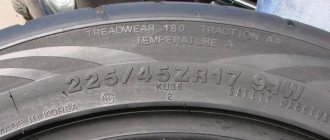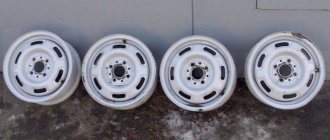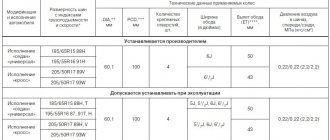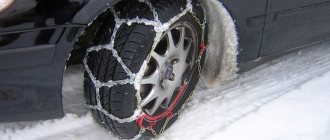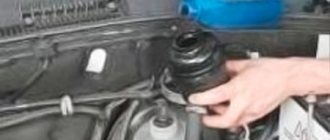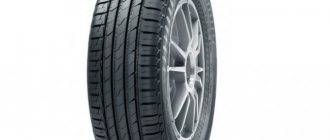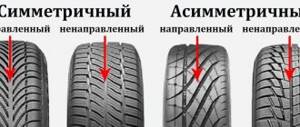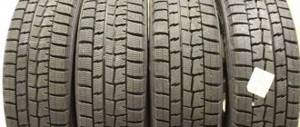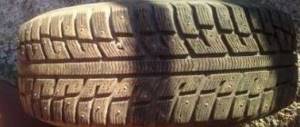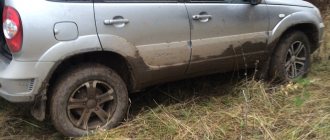Tire size is one of the most important parameters that can significantly change the behavior of a car on the road. In our review we will tell you about the permissible tire size on the Grant, as well as what the size of the tires affects during the operation of the car. Let's start with the tire and wheel sizes allowed by the manufacturer.
Basic tire sizes
In principle, to find out what size tires can be installed on a Lada Granta, just look at the passport or at the plate on the inside of the car door.
Nevertheless, we present to your attention a list of parameters that the manufacturer declares using the example of modifications for the 2020 release:
| Modification | Basic size | Replacement options |
| 2190 Sedan/1.6 16V | R14 175/65 | R14 185/60R15 195/50 and 185/55 |
| 2190 Sedan/1.6 8V | R14 175/65 | No options |
| 2190 Sedan/1.6 16V Sport | R15 185/55 | R15 195/50R16 195/50 |
| 2191 Liftback/1.6 16V | R14 175/65 | R14 185/60R15 185/55 |
| 2191 Liftback/1.6 8V | R14 175/65 | R14 185/60R15 185/55 |
Tire size table for Lada Granta Sport
“Lada Granta Sport” is one of the luxury modifications of the popular VAZ model, which has a fairly powerful 1.6i engine with 113 horsepower. For this configuration, the concern's engineers equip the car with wheels that are more durable than the simpler versions of this car. Recommended wheel rim parameters for Granta Sport are given in the following table:
| Rim width, inches | Disc diameter, inches | Reach (ET indicator), mm | Wheel bolt pattern (pcs x mm) | DIA (diameter of the central hole), mm |
| 6J | 15 | 35 | 4×98 | 58,6 |
| 6J | 16 | 35 | 4×98 | 58,6 |
| 6.5J | 16 | 33 | 4×98 | 58,6 |
| 7J | 17 | 30 | 4×98 | 58,6 |
When purchasing new disks, it is advisable to adhere to these ratios. Otherwise, the wheel may begin to protrude beyond the side dimensions of the body, touch wheel arches, fender liners, mudguards, or have unforeseen impacts on suspension elements.
R17 wheels on Lada Granta Sport
In addition to rims, drivers must choose tires correctly, because for normal operation of the car all the parameters of the wheel assembly are important, and not its individual parts. Below is another table that clearly displays all the compatibility indicators of Granta Sport wheels for the above wheel parameters:
| Sole width, mm | Profile height, mm | Bore diameter, inches | Speed index/permissible speed, km/h | Load index, kg/wheel | Required cylinder pressure, PSI |
| 185 | 55 | 15 | H/210 | 82/475 | 2,1 |
| 195 | 50 | 16 | V/240 | 82/474 | 2,1 |
| 205 | 45 | 16 | V/240 | 82/475 | 2,3 |
| 205 | 40 | 17 | W/270 | 81/462 | 2,3 |
You might be interested in this About mud tires on UAZ
Important!
Speed index is an indicator resulting from the load index. It means the maximum dynamics of the car for 30 minutes under the influence of the maximum load, taken into account by the corresponding index. As for the size 14 tires on the Grant, they are not used in the sports version of the car.
Tire pressure
We found out which tires are suitable for the Lada Granta - now we’ll figure out the pressure. A lot depends on it during the operation of tires, the purchase of which is one of the sources of expense for any car owner. The pressure must be constantly monitored to ensure that the tires do not wear out too quickly.
Premature wear occurs when there is insufficient pressure, but over-pumping is also fraught with consequences.
- If the pressure is regularly lowered by 0.5 Atm less than the norm for 14 radius of 1.9 Atm in the front, and 2.0 Atm in the rear, the tires will last 4 times less - plus fuel consumption increases.
- With an even greater lack of pressure, the car may lose control and the braking distance increases.
- If you drive for a long time on half-flat tires and then inflate them, the tire may simply explode.
Therefore, you need to have a pressure gauge on hand, take measurements from time to time (especially in winter), and if you need to pump up the wheels. The front and rear pair of tires should have the same pressure.
Specific indicators depend on the wheel size. Take, for example, the 195/50 profile, which is one of the replacement options for the LADA Sedan Sport. If this is a radius of 15, then the optimal pressure is 2.3 Atm, and at radius 16 you need to pump 2.4 Atm.
What is the effect of different tire and wheel sizes?
| Options. | Increasing the diameter of the disc. | Increasing the width of the disk. | Increasing tire width. |
| Exterior of the car. | will improve | will improve | will improve |
| Behavior on the road. | will improve | will improve | will improve |
| Control stability. | will improve | will improve | will improve |
| Road grip. | Will not change | Will not change | Will improve |
| Resistance to gliding on the water surface. | Will not change | Will not change | will get worse |
| Comfort while traveling on rough roads. | will get worse | Will not change | will improve |
| Noise from the road surface. | Will not change | Will not change | will increase |
| Gasoline consumption. | Will not change | will increase | will increase |
| Tire wear. | Will not change | Will not change | will increase |
Selection of tires by model
Knowing the size of the “shoes”, all that remains is to choose the style. Any car should have two sets of tires: winter and summer. Winter tires are installed without waiting for frost, but when the thermometer regularly drops below +5 degrees.
To save on the purchase of winter tires, some drivers make the mistaken decision to drive all-season tires. Therefore, we will make a small digression and explain why this should not be done.
When and what tires are needed for a car?
Let’s say right away that there are no tires that behave stably in any conditions. Why then is the tire called all-season? Because of the tread, which must have a deep relief and grooves through which water, dirt, and slush can easily pass.
All-season tires are tires that are comfortable to drive in the off-season, when the air temperature varies from +7 to -10 degrees. It is often marked M+S (mud/snow), which confuses many.
But in fact, an all-season tire is a summer tire and is not suitable for year-round driving, even in the southern regions of the country.
- All mud tires, and all winter tires, have an all-season tread. The only difference is in the rubber composition, which is designed for positive or negative wheel operation. On a winter tire, for better grip on icy roads, many thread-like sipes are made, which distinguishes it from all-season tires.
- Studless winter tires are popularly called Velcro. On such tires, the car feels great in icy conditions, but when the temperature outside is consistently positive (above +6-7 degrees), it must be changed to summer shoes.
- Winter tires are much softer, so if you try to drive them in the summer, they will wear out quickly. Studded tires are better suited for driving on snow, so when in winter you have to drive not on cleared asphalt, but on a country road, it is better to give preference to studded tires.
- All year round, all-season vehicles are driven mainly by trucks and buses, on which changing wheels is a labor-intensive process, and besides, there are usually more than four of them. True, in severe frosts and snowfalls they have a hard time riding on such tires.
And another important factor is for those who spend a lot of time driving. A tire for winter use is much softer than a summer one, but it is also noisy when driving, especially the studded one.
The summer one, and it is also an all-season one, in severe frosts “steals” and just rattles. And this is not to mention the fact that you will not so much ride on the ice as perform figure skating.
Winter tires on Lada Granta
Now let's see which winter tires to choose for the Lada Granta:
Viatti Brina Nordico
A relatively new model, developed by the German Continental together with Italian engineers, and put into production at the facilities of the Nizhnekamsk tire plant.
An asymmetrical tread pattern, a combination of middle blocks with rows of studs along the edges and variable sidewall stiffness technology ensure safe movement and stability when cornering and when crossing uneven roads.
Toyo Observe Garit G3-Ice
Winter tires from the Japanese Toyo are deservedly considered one of the best. If previously only sellers and those who drove it knew about this, then a test carried out at the test site not so long ago left no doubt.
Observe Garit G3-Ice tires competed with the Finnish Hakkapeliitta-7, slightly inferior to it in snowy areas and taking the lead on the compacted track. Experts believe that the whole point is in the studs, which protrude beyond the surface of the tire by 1.2 mm more than normal.
Goodyear UltraGrip 600
Another new product. Atypical tread pattern - as is the case with all Goodyear models. Looking at it, you get the impression that a solid wheel is simply cut into grooves. They provide the tire with excellent handling in loose snow.
Another distinctive feature is the hexagon-shaped studs, which make it possible to quickly accelerate and brake safely.
Hankook W429 i Pike
Winter studded tires of different generations from the Korean manufacturer Hankook have long established themselves as an excellent combination of price and quality. The latest model has been slightly redesigned; the shape of some tread elements has slightly changed, although the symmetry of the pattern and directionality have been preserved.
Massive blocks on the sides replaced narrow ribs, and the tire began to work better in icy conditions.
Brake disc parameters
If you look closely, you can identify several important parameters by which the product is selected.
A – outer diameter of the product, mm;
B, C – maximum and minimum thickness, respectively, mm. If the surfaces are worn out by 2 mm on both sides, such a disk should be replaced with a new one;
D – product height, mm;
G – diameter of the central circle (wheel axis), mm;
H – hub diameter, mm;
I, Fx – diameter and number of fastening bolts, mm.
Often these parameters are not used when selecting brake discs. No one will look for a stale part in a warehouse by size. The easiest way is to select it by vin number. Each car is produced under a specific number, which is a kind of key to all the parts and mechanisms installed in the car.
The best models for summer
Now let's present several worthy summer models:
Bridgestone Ecopia EP150
The tread of this Japanese tire is developed using a new technology (NANO-PROTECH), which makes it possible to reduce the coefficient of rotational resistance and, as a result, save fuel consumption. Plus, the EP150 turned out to be lighter in weight and almost silent.
Nitto NT860
Another Japanese tire produced in Malaysia. Very soft rubber, perfectly balanced and brakes, thanks to the deep tread, self-cleaning from dirt and snow. With all this, the best thing is the low price.
Kormoran Impulser B2
Serbian Kormoran was developed using Michelin technology. The tire is stable when driving at speed, does not “float” if it gets into a puddle, has excellent grip on the road and is controlled when cornering.
Matador MP 47 Hectorra
The new generation summer tire from Slovenia MP-47 Hectorra performs excellently on both dry and wet surfaces thanks to its asymmetrical pattern with four deep longitudinal grooves.
Tread elements are optimized to the maximum, which improves acceleration and braking efforts and reduces noise levels.
Conclusion
Which winter tires are best for a car, or what to put on it for the summer, is, of course, up to the owner to decide. It all depends on what climate zone you have to use the car and what roads you drive on. And our information is designed to understand the characteristics of certain models and the advisability of their use.
